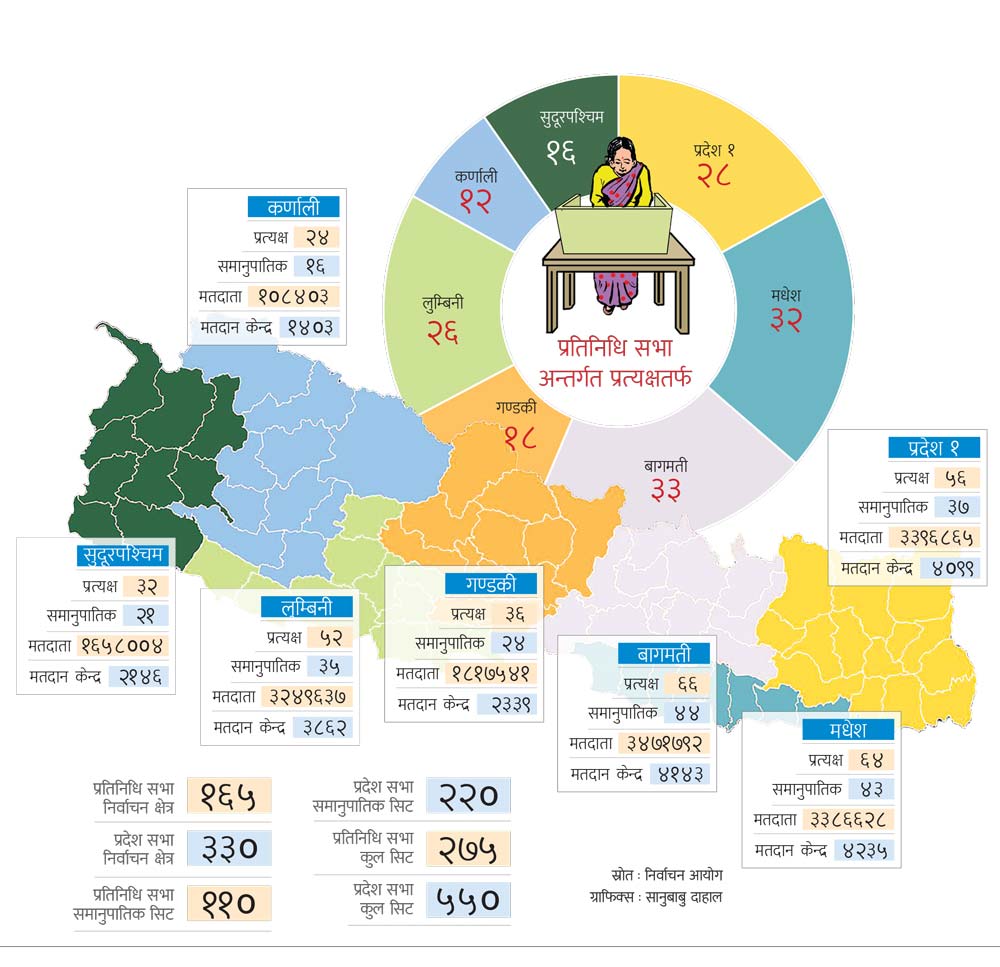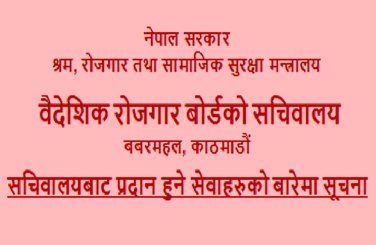
The election of members of the House of Representatives and Provincial Assembly is being held on Sunday, 20 November 2022. This is the first periodical election to be held for both houses after the promulgation of the constitution.
275 members of the House of Representatives will be elected from 7 am to 5 pm. 165 people will be elected by first-past-the-post (FPTP) and 110 people by Proportional Representation (PR) electoral system.
330 people will be elected through the first-past-the-post (FPTP) and 220 people will be elected through the Proportional Representation (PR) electoral system in the state assembly. The schedule of the commission is to start the counting of votes as soon as the ballot boxes are collected after the election and to be able to count toward the FPTP within three days.
According to the Election Commission, 61 political parties are participating on the FPTP side and 47 on the PR side of the House of Representatives. 2412 candidates, consisting of 2187 men and 225 women, are competing for the FPTP of the House of Representatives. There are 2199 candidates for PR. The number of female candidates is 1200. There are 3,224 candidates for FPTP and 3,708 candidates for PR in all seven provinces under the Provincial Assembly. Thus, 5636 candidates for FPTP and 5907 candidates for PR are in the election contest across the country.
One crore 79 lakh 88 thousand 570 voters are eligible to vote in the election. There are 88,47,579 women and 91,40,806 men and 185 voters from other groups. According to the commission, 10,892 polling stations and 22,227 polling stations have been designated for voting.
Types of Ballots:
During the voting process, a voter will have to mark the swastika on four ballot papers. Four types of ballot papers, two of which are FPTP and PR for the House of Representatives and two for the Provincial Assembly, FPTP and PR, will have to be marked with the Swastika symbol.
According to the commission, there will be a ballot paper marked with a red election symbol on a white background for the FPTP side of the House of Representatives. On the PR side of the House of Representatives, a black ballot paper is printed on a white background. Ballot papers with red election symbols on a white background for FPTP and black election symbols on a white background for PR have been printed.
A total of 80 million 421 thousand 500 ballots have been printed for voting, 398 million 16 thousand five hundred for FPTP and 46 million 500 for PR.
Provisional voters will be able to vote only for the PR of the House of Representatives. The number of such voters is 450,000. 141 centers have been designated for provisional voters.
Staff Mobilization:
The Election Commission has mobilized 246 thousand 960 employees for the general election. According to the commission, at least seven and at most nine employees have been mobilized in one polling station. A total of 22,227 polling stations have been designated across the country.
Rishi Ram Bhusal, Assistant Spokesperson of the Commission, informed that the employees are appointed based on the number of voters in the polling station. Seven employees have been deployed in polling stations with 250 voters, eight employees in polling stations with up to 500 voters, and nine employees in polling stations with more than 500 voters.
Seven to nine employees including one polling officer, one assistant polling officer, two assistants, and two assistants and volunteers have been mobilized in the polling station.
Observers:
The Election Commission has said that seven thousand 219 observers will be mobilized in the general election. According to the commission, 12 people from two international observer organizations and seven thousand 27 people from 44 indigenous organizations will supervise the election.
In order to increase the fairness of the election and to increase the credibility of the election through supervision, the commission has been conducting supervision from neutral organizations. 18 diplomatic missions have taken permission from the Commission for election observation. Chief Election Commissioners of four countries namely India, Bangladesh, Bhutan, and Maldives, the Commissioner of South Korea, and the State Minister of Japan will observe the election.
Vote Counting:
The Election Commission has said that the counting of votes will begin immediately after the voting is over. The commission has prepared to complete the counting of votes for the FPTP of the representatives and provincial assemblies within three days.
The election officer's office has been established in the constituencies far away from the headquarters. According to which, the counting work will also be done in the election officer's office in the respective area.
The election officer's office will prepare the counting after receiving the ballot boxes. The election officer's office will start the counting of votes in accordance with the House of Representatives and Provincial Assembly member election (counting) guidelines after all-party discussion and informing them about the legal provisions related to the counting of votes. Assistant Spokesperson Bhusal said that the counting of representatives and provincial assembly members towards FPTP will start at the same time.
There will be a counting team of six people for each constituency. The election officer's office can count votes at a maximum of 15 places in one constituency as per the requirement.
Likewise, 28 people will be elected from Province 1, 32 from Madhesh, 33 from Bagmati, and 18 from Gandaki under the House of Representatives. FPTP will elect 26 members from Lumbini, 12 from Karnali, and 16 from Far West.
On the PR side of the House of Representatives, 110 seats will be decided based on the votes received by the party. According to Yagya Prasad Bhattarai, Assistant Election Officer of the PR Election System, to be elected to the House of Representatives in PR, a political party must have received at least three percent of the total votes cast. In the province, to be eligible for the allocation of 220 seats to PR, a political party must have received 1.5 percent of the total votes cast. But to get national recognition, the party must have won three percent in PR and at least one seat in FPTP towards the House of Representatives.






